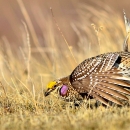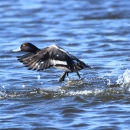About Us
Chase Lake National Wildlife Refuge was established in 1908 under President Theodore Roosevelt as a reserve and breeding ground for native birds, making it the 15th refuge established in the country. Chase Lake has one of the largest American white pelican nesting colonies in North America. That said, the year the Refuge was established, only 50 pelicans inhabited the area, as written by local settler H.H. McCumber. In 2000, a record 35,466 breeding pelicans were tallied at the Refuge.
Our Mission
Each unit of the National Wildlife Refuge System is established to serve a statutory purpose that targets the conservation of native species dependent on its lands and waters. All activities on those acres are reviewed for compatibility with this statutory purpose.
The mission of the National Wildlife Refuge System is to administer a national network of lands and waters for the conservation, management and, where appropriate, restoration of the fish, wildlife and plant resources and their habitats within the United States for the benefit of present and future generations of Americans.
Our History
In the mid to late 1800s, there were great numbers of American White Pelicans on Chase Lake. By the turn of the century, those numbers were reduced dramatically as Euro-Americans made a regular practice of going to Chase Lake on Sunday afternoons to see how many pelicans they could kill.
In 1905, H.H. McCumber came to the area and noted that there were only 500 pelicans, and that those numbers continued to decrease. H.H. McCumber petitioned the U.S. Biological Survey, the predecessor to the U.S. Fish and Wildlife Service, to designate the area as a bird refuge. In August of that year it was established as a bird sanctuary; there were only 50 pelicans remaining. H.H. McCumber was designated the first federal game warden for the Refuge. In 1918, before he left, McCumber stated that there were 2,500 to 3,000 pelicans at the Refuge.
Several other colonial nesting waterbird species also utilize the refuge to nest. In recent years, the Refuge islands likely supported over 40,000 breeding birds (2013 estimates were over 50,000) including pelicans, egrets, gulls, and herons. In 2001, the Refuge was identified one of America's Top 100 Globally Important Bird Areas by the American Bird Conservancy.
Other Facilities in this Complex
Chase Lake National Wildlife Refuge is part of the Eastern North Dakota Complex. A National Wildlife Refuge Complex is an administrative grouping of two or more refuges, wetland management districts or other refuge conservation areas that are primarily managed from a central office location. Refuges are grouped into a complex structure structure
Something temporarily or permanently constructed, built, or placed; and constructed of natural or manufactured parts including, but not limited to, a building, shed, cabin, porch, bridge, walkway, stair steps, sign, landing, platform, dock, rack, fence, telecommunication device, antennae, fish cleaning table, satellite dish/mount, or well head.
Learn more about structure because they occur in a similar ecological region, such as a watershed or specific habitat type, and have a related purpose and management needs. Typically, a project leader or complex manager oversees the general management of all refuges within the complex and refuge managers are responsible for operations at specific refuges or wetland management districts. Supporting staff, composed of administrative, law enforcement, refuge manager, biological, and fire, are centrally located and support all stations within the complex.








